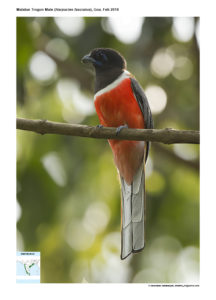Malabar Trogon

Malabar Trogon Harpactes fasciatus
Etymology:
- Harpactes : Greek Word for “Robber”
- fasciatus : Latin word for “ banded, striped “
Vernacular Names:Hindi: Kufnichiri, Guj: Lajana, Suhagan, Mar: Malabar Karna, Mal: Theekakka, Kan: Kakarnehakki, Sinh: Ginikurulla, Nawanilakurulla, Ranwankondea
Distribution in India: Resident of Western Ghats, Hills of Tamil Nadu and Eastern Ghats.
Description: Size of 29-30 cm.The male has a slaty black head and breast with a white border to the black bib separating it from the crimson on the underside. The back is olive-brown to chestnut. The wing coverts are black with fine white vermiculations. The central tail-feathers are chestnut with a black tip, with the second and third pairs from the middle having more black than chestnut. The outer three pairs have long white tips. The female lacks the contrasting black and crimson and has only a slightly darker head and breast that shades into the olive brown on the back while the crimson of the underside of the male is replaced by ochre. In both sexes, the beak is bluish as is the skin around the eye. The iris is dark brown and the feet are pale bluish. The nostrils are covered by tufts of filoplumes. The feet are heterodactyl, a feature unique to the trogons, with the digits I and II facing back and digits III and IV pointing forward.
Habitat: It is found in Middle storey of dense primary and secondary broadleaf evergreen, semi-evergreen and moist forest
Food Habits: It mainly eats insects and worms.The females tending to forage lower within the canopy while the male is higher canopy feeder. When foraging on bark, it proppes itself using the tail like woodpeckers, especially on decaying tree stumps. It sometimes descend to the ground and search for insects under leaf litter. It will sometimes fly and try to flush prey and then hover to pick up prey. It may also hang upside down to reach prey on vertical tree surfaces. Prey are often mashed or struck on a branch between the mandibles before feeding on them or prior to feeding young.
Breeding Habits: They are socially monogamous with pair bonds lasting more than a season .They breed in Feb-Jun.The nest is made in rotting trees or stumps that are easy to carve and pulverize using their bills. The male and female take turns to excavate the nest using their bills. It may take about a month to excavate the nest. The floor is made out of the wood powder and no extra lining is added. They lay 2-3 eggs.The eggs are laid with a gap of two days and incubated by both males and females with the females usually incubating at night. The incubation period is about 19 days. The hatchlings are fed mainly caterpillars for the initial period and later provided bugs, flies and orthopterans. The parents do not remove the excreta of the nestlings from the nest. The adults continue to feed the fledged juveniles for nearly 5 to 6 months.